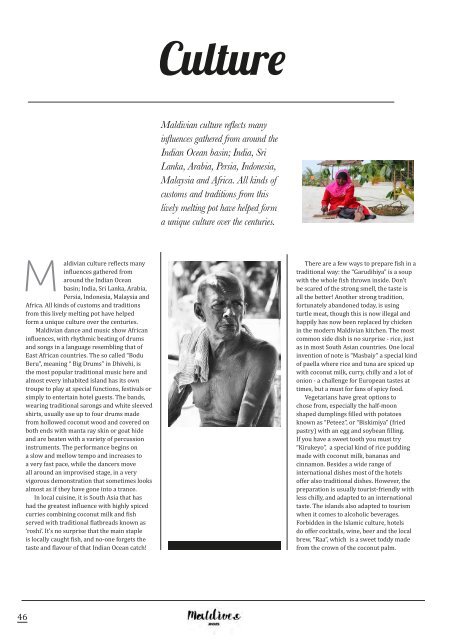Create successful ePaper yourself
Turn your PDF publications into a flip-book with our unique Google optimized e-Paper software.
Culture<br />
Maldivian culture reflects many<br />
influences gathered from around the<br />
Indian Ocean basin; India, Sri<br />
Lanka, Arabia, Persia, Indonesia,<br />
Malaysia and Africa. All kinds of<br />
customs and traditions from this<br />
lively melting pot have helped form<br />
a unique culture over the centuries.<br />
Maldivian culture reflects many<br />
influences gathered from<br />
around the Indian Ocean<br />
basin; India, Sri Lanka, Arabia,<br />
Persia, Indonesia, Malaysia and<br />
Africa. All kinds of customs and traditions<br />
from this lively melting pot have helped<br />
form a unique culture over the centuries.<br />
Maldivian dance and music show African<br />
influences, with rhythmic beating of drums<br />
and songs in a language resembling that of<br />
East African countries. The so called “Bodu<br />
Beru”, meaning “ Big Drums” in Dhivehi, is<br />
the most popular traditional music here and<br />
almost every inhabited island has its own<br />
troupe to play at special functions, festivals or<br />
simply to entertain hotel guests. The bands,<br />
wearing traditional sarongs and white sleeved<br />
shirts, usually use up to four drums made<br />
from hollowed coconut wood and covered on<br />
both ends with manta ray skin or goat hide<br />
and are beaten with a variety of percussion<br />
instruments. The performance begins on<br />
a slow and mellow tempo and increases to<br />
a very fast pace, while the dancers move<br />
all around an improvised stage, in a very<br />
vigorous demonstration that sometimes looks<br />
almost as if they have gone into a trance.<br />
In local cuisine, it is South Asia that has<br />
had the greatest influence with highly spiced<br />
curries combining coconut milk and fish<br />
served with traditional flatbreads known as<br />
‘roshi’. It’s no surprise that the main staple<br />
is locally caught fish, and no-one forgets the<br />
taste and flavour of that Indian Ocean catch!<br />
There are a few ways to prepare fish in a<br />
traditional way: the “Garudihiya” is a soup<br />
with the whole fish thrown inside. Don’t<br />
be scared of the strong smell, the taste is<br />
all the better! Another strong tradition,<br />
fortunately abandoned today, is using<br />
turtle meat, though this is now illegal and<br />
happily has now been replaced by chicken<br />
in the modern Maldivian kitchen. The most<br />
common side dish is no surprise - rice, just<br />
as in most South Asian countries. One local<br />
invention of note is “Masbaiy” a special kind<br />
of paella where rice and tuna are spiced up<br />
with coconut milk, curry, chilly and a lot of<br />
onion - a challenge for European tastes at<br />
times, but a must for fans of spicy food.<br />
Vegetarians have great options to<br />
chose from, especially the half-moon<br />
shaped dumplings filled with potatoes<br />
known as “Peteez”, or “Biskimiya” (fried<br />
pastry) with an egg and soybean filling.<br />
If you have a sweet tooth you must try<br />
“Kirukeyo”, a special kind of rice pudding<br />
made with coconut milk, bananas and<br />
cinnamon. Besides a wide range of<br />
international dishes most of the hotels<br />
offer also traditional dishes. However, the<br />
preparation is usually tourist-friendly with<br />
less chilly, and adapted to an international<br />
taste. The islands also adapted to tourism<br />
when it comes to alcoholic beverages.<br />
Forbidden in the Islamic culture, hotels<br />
do offer cocktails, wine, beer and the local<br />
brew, “Raa”, which is a sweet toddy made<br />
from the crown of the coconut palm.<br />
46

















